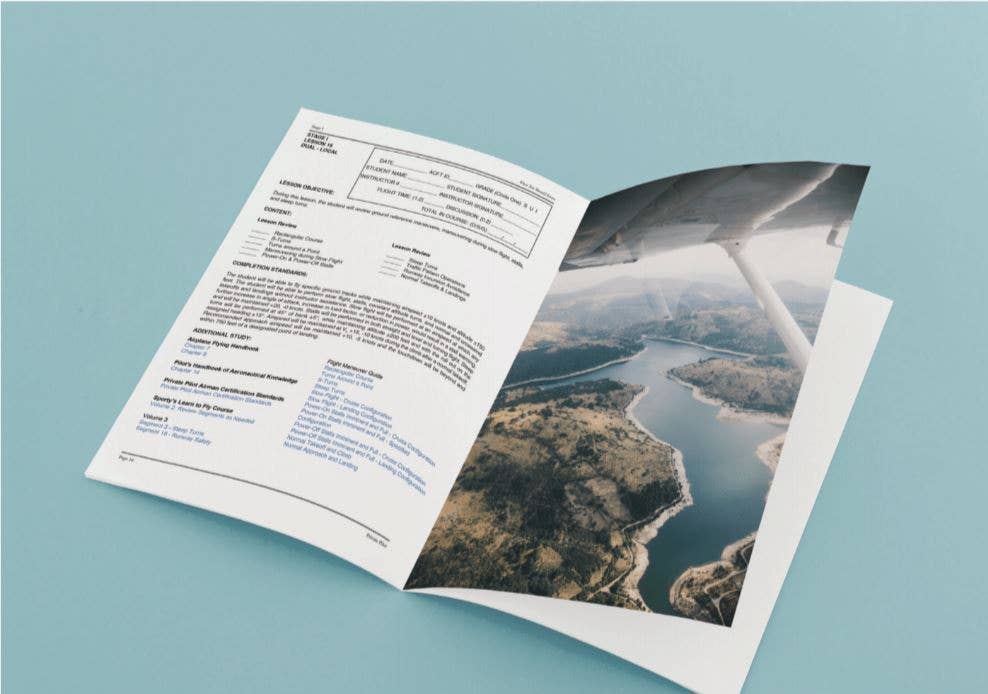Use A Syllabus
Organization, communication, expectation, thy name is syllabus.

[Photo illustration: Amy Jo Sledge, Images: iStock, Meg Godlewski]
Would you pay thousands of dollars for a class and invest hundreds of hours if you didn’t know what material was going to be covered, or when the quizzes and tests were, and what was considered a passing grade? Most people wouldn’t, yet every day hundreds of people essentially do this when they show up for flight training and it is conducted without the benefit of a syllabus.
If you're not already a subscriber, what are you waiting for? Subscribe today to get the issue as soon as it is released in either Print or Digital formats.
Subscribe NowIs a syllabus required for flight training? The FAA does not mandate the use of a syllabus under Part 61. However,under Part 141, pilot schools are required to use a structured training program that includes a syllabus. The elements and knowledge requirements of Parts 61 and 141 are identical—the experience requirements are slightly different, however, as a private pilot applicant who has trained under Part 141 can qualify to take the check ride at 35 hours, as compared to 40 hours under Part 61.
Is a syllabus useful for training? Yes, it is. It’s like a road map for both instructor and learner, showing you where you are heading in training and what milestones await. Under Part 61, the CFI can create their own syllabus using the FARs and the standards for the certificate or rating they are teaching, or they can purchase an off-the-shelf product like a syllabus from Jeppesen, Cessna, Sporty’s, or King Schools.
Ostensibly, these syllabi were designed to get the applicant through training in the minimum amount of time. They are often used in Part 141 programs. Therefore, the syllabus indicates the minimum time that should be spent on each lesson and the elements that need to be covered. Under Part 141, the syllabus has to be strictly followed, and this lack of flexibility can make it difficult to adjust for weather, student and/or medical certification delays, and mechanical issues.
There is nothing that says a CFI can’t take a syllabus that was designed for Part 141 instruction and apply it during Part 61 training. Indeed, many CFIs who trained at 141 programs but went on to teach under 61 often use the syllabus they trained with at their place of employment; however, they don’t have to adhere to the Part 141 time constraints or sequence requirements.
CFIs who create their own syllabus can adjust for towered vs. nontowered airports, airspace, equipment available, weather, their teaching style, and the knowledge acquisition style of learners. Often these syllabi are adjusted as the instructor’s experience changes.
Rod Machado, flight instructor, aviation author, and humorist, created a syllabus that dovetails into his popular online ground school. “A good syllabus covers what is necessary and no unnecessary things,” says Machado.“A flight instructor can look at the different syllabi available and find the one that is most useful and get rid of what is not for the training they are providing. The syllabus provides the CFI guidance, but they shouldn’t be using it to just check the boxes. They need to tailor the lesson to the learner and not be a slave to the syllabus.”
The way a syllabus presents the information is important, says Machado, who advocates the building block approach, which organizes training that begins with the most basic tasks—such as takeoffs, climbs, turns, and descents—and builds on them as the learner’s skill and experience grow. “The syllabus also needs to also be time ‘do-able,’ as the length of the lessons need to make sense and be practical. They can’t be too long.”
Can you imagine walking into a college classroom and the instructor asking, “What shall we do today?” A variation of that happens all the time when a syllabus is not used, says Michael McCurdy, owner and CEO of CHS Flight School at Charleston International Airport (KCHS) in South Carolina.
“If the CFI was not trained using a syllabus, there is a good chance they won’t use it to train their learners. You can tell this has happened when the CFI greets the learner by asking, ‘What do you want to do today?’ and the client replies, ‘You’re the instructor, shouldn’t you know what we’re going to do?’”
McCurdy’s school operates under Part 61 with a syllabus created in-house, built around using the Redbird FMX as a procedures trainer. The learners gain skills on the ground where the instructor can control the weather, then move out to the airplane—and are better prepared. This leads to quick progress and successful check rides.
Flight instruction is a second career for McCurdy—his first was law enforcement. He has been a CFI for 20 years and says the learners—not the instructors—get the most out of the syllabus.
“If you are organized and have experience, maybe you, the CFI, don’t need a syllabus—but the learners appreciate using one so they know where they are at and what is down the road for them.”
McCurdy’s school often picks up clients who were training elsewhere without a syllabus and left because they didn’t feel they were making progress. Some CFIs compare this to playing football and not knowing where the goal posts are.
“The lack of a syllabus during my initial training resulted in uncertainty on my part about what was required and where I was in terms of progress,” recalls Karen Kalishek, chairman of the National Association of Flight Instructors, a designated pilot examiner, and an airline transport pilot. “When my instructor went on vacation, the lessons with a replacement were largely redundant since there had been no tracking.”
“In today’s environment with rapid turnover of CFIs—which makes it more likely that a learner will experience transition to another primary flight instructor—I highly recommend using a syllabus,” Kalishek continues. “It is a tool to track progress, increase efficiency, save training dollars and support good communication between the instructor and learner.
This article was originally published in the March 2023 Issue 935 of FLYING.

Sign-up for newsletters & special offers!
Get the latest FLYING stories & special offers delivered directly to your inbox







